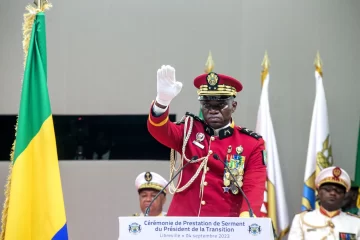Editor’s note: This is the first instalment of a two-part series on the increasingly regionalized conflict in Ethiopia’s Tigray region. To read part two, click here.
The prestigious Nobel Peace Prize prize sits in a glass vitrine at the Ethiopian Ministry of Peace, having been awarded to Ethiopian Prime Minister Abiy Ahmed in 2019 for his efforts to achieve peace and international cooperation, and in particular his decisive initiative to resolve the border conflict with neighbouring Eritrea. Fast-forward to late 2020, and Ethiopia, which is built on a ethno-federalist structure and divided into 10 administrative regions, has found itself on the brink of civil war with Prime Minister Abiy at the helm.
Tigray and TPLF’s trajectory
In early November, Prime Minister Abiy accused the governing party of the northern Tigray region in Ethiopia, Tigray People’s Liberation Front (TPLF), of attacking the Northern Command of the Ethiopian National Defense Force (ENDF). Abiy claimed the TPLF sought to destabilize the federal government. In response to TPLF’s alleged attack, the federal administration unleashed a military campaign and full communications blackout on Tigray. The region is home to an estimated 6 million people, 600,000 of whom are dependent on food aid.
Prime Minister Abiy’s antagonistic relationship with TPLF is not incidental. Before the Prime Minister came into power in 2018, the TPLF reigned for 27 years after helping to topple Ethiopia’s Marxist dictatorship in 1991. The party dominated Ethiopia’s military and political life. Last year, the ruling coalition led by the TPLF was dissolved, and most of the constituent parties were merged into a single party under the leadership of Abiy. The TPLF refused to join. The party, which has battled widespread corruption and fraud allegations, has worked to undermine Prime Minister’s Abiy’s reform agenda and argues that the Prime Minister’s mandate to rule expired after COVID-19 prompted the postponement of elections in August. The matter has been further compounded by TPLF’s defiant decision to hold its own elections in Tigray in September, which the federal government considered illegitimate. The escalating tensions between Abiy and the TPLF finally culminated in the accusation of a TPLF attack on the ENDF and the subsequent military retaliation.
As the ENDF approached Tigray with the aim of capturing the capital city of Mekelle, the federal government’s public outreach referred to the operation as an internal matter and a “rule of law enforcement operation”. The government systematically rejected international mediation efforts, citing territorial sovereignty, and called on the international community to adhere to the principle of non-intervention in internal affairs.
The fall of Mekelle
Though TPLF fighters are thought to number about 250,000, they were unable to defend their territory against the ENDF. Mekelle, a city with half a million inhabitants, fell within a week. In a public announcement, the ENDF claimed that the army had taken control of Mekelle without causing any damage to the city’s infrastructure or incurring any civilian casualties. ENDF’s announcement echoed the Prime Minister’s messaging that the operations had been completed and their focus will be on rebuilding, providing humanitarian assistance, and apprehending TPLF leadership figures.
Though the capture of Mekelle bolsters the position of the Prime Minister, the war is not over. The TPLF has rejected the Prime Minister’s victory proclamation. Rather than fight for its stronghold, the TPLF appears to have withdrawn. The party has a history of armed resistance and it is likely that lengthy guerrilla warfare will occur as its fighters are familiar with exploiting its mountainous terrain and borders with Sudan and Eritrea. Furthermore, TPLF leader Debretsion Gebremichael has been actively reaching out to international media outlets and recently claimed that his forces shot down an ENDF plane and regained control of the Tigrayan town of Axum.
The Mai-Kadra massacre
The Ethiopian Human Rights Commission has blamed a TPLF-linked militia for the massacre of 600 civilians from the neighbouring Amhara region in the town of Mai-Kadra in Tigray, a few days after the ENDF attack on Mekelle. According to the Commission, the militia stabbed, bludgeoned and burned to death non-Tigrayan residents of the town. The TPLF has denied this accusation, and cites it as propaganda promulgated by the federal government. With communications being gradually restored, damning testimonies from refugees and survivors have emerged of atrocities being committed by both sides.
The UN High Commissioner for Human Rights expressed alarm over further violations of international humanitarian law and called on all sides to give “clear and unambiguous orders to their forces” to spare civilians. Though the communications blackout and limited humanitarian access mean the UN has been unable to directly monitor the situation, the organization has taken note of the reports of arbitrary arrests and detentions, killings, and discrimination and stigmatisation of ethnic Tigrays.
Humanitarian access and the human cost
It is believed that thousands have been killed and nearly 1 million people have been displaced. Refugee camps in Tigray that are home to nearly 100,000 Eritrean refugees have been directly in the line of fire. In early December, the UN announced that it signed a deal with the federal government to allow unimpeded humanitarian access for areas under federal control. Though Prime Minister Abiy’s administration initially promised a “humanitarian corridor” managed by the federal government, several international and multilateral organizations have voiced concerns that access for international aid workers remains constrained. The UN remains concerned about over 100 unaccounted aid workers in Tigray and, disturbingly, it recently emerged that several humanitarian workers on the ground have been killed.
The government has clarified that it stands ready to support the return of all Ethiopians that have fled and that humanitarian assistance will be further reinforced with the opening of a humanitarian access route managed by the Ministry of Peace. The Ministry, which recently admitted ENDF troops shot at and detained UN staff trying to visit a camp for Eritrean refugees in Tigray, is the very same one where the Nobel Peace Prize sits.
Read “Ethiopian Enmity, Part Two: Conflict Regionalizes” here.


